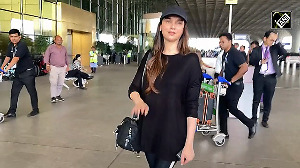The CRPF and local police on anti-Naxal operations perform a thankless job but a few basic counter-insurgency measures could have prevented the deadly Dantewada attack, writes B Raman.
6/4 will go down as a black day in the history of India's counter-insurgency just as 26/11 became a black day in the history of Indian counter-terrorism.
In a well-prepared and well-executed attack of unprecedented mobilisation, precision and savagery a large number of Maoists (Naxalites -- estimated by the local police to be about 1,000 strong -- ambushed a combined party of over 80 members of the Central Reserve Police Force and the district police returning from road security duty and managed to kill 75 members of the CRPF and local police force on April 6.
The Maoists had reportedly taken up position on a hill overlooking the route by which the party was returning after performing its task. It is not clear whether the route was a regular road or a motorable jungle track. The ambush took place in the thick Mukrana forests of Chhattisgarh's Dantewada district.
The fact that the Maoists were able to mobilise such a large number of persons for the ambush would indicate that they had advance indication of the return of the CRPF party by that route. They might have had advance intelligence of the plans of the party or they might have assessed that the CRPF might be returning by this road after watching the CRPF men conduct search and destroy operations in the area for three days.
A rule of precaution in counter-insurgency operation is that you don't use the same route for going to an operational area and returning. Often, this precaution is not followed by the security forces either due to carelessness or due to the fact that the security forces do not have much of a choice due to the poor development of roads in the jungle areas in which the Maoists operate.
One may recall an incident a couple of years ago when a large police party had gone by boat from Andhra Pradesh into Orissa. The Maoists had noticed them going and had correctly assessed that the party would be returning by the same route. When they did, a large number of Maoists had taken up position on a raised feature overlooking the river and they literally mowed down over 50 members of the police party.
We have probably not learnt the right lessons from the river ambush and facilitated a deadly road ambush in thick forests by not following basic dos and don'ts of counter-insurgency. The CRPF and the police have to perform a thankless task for want of proper road and telecommunications networks in the Maoist-infected areas. While the Maoists are trained to trek long distances by foot, the security forces tend to be road and vehicles-bound.
They become sitting ducks for the insurgents, who surprise them with explosives and landmines and then mow them down with hand-held weapons. The reflexes of the security forces tend to be weak as could be seen from the fact that there have been very few instances of an ambushed security forces patrol recovering from the ambush and retaliating against the Maoists. Ambushes always tend to be fatal for the security forces with very few instances of successful counter-ambushes by the security forces.
Continuing serious deficiencies in rural policing and in police-rural communities relationships have been coming in the way of village help for the police by way of preventive intelligence. Counter-intelligence in the rural areas to prevent the penetration of the security forces by the Maoists is also weak. The fact that only one member of the police was killed in the ambush makes one suspects possible collusion between the Maoists and some members of the district police.
Since the Maoists and the local police recruits are recruited from the same rural stock, possibilities of penetration of the new police recruits by the Maoists are high.
The time has come to think in terms of using helicopter patrols and spotter drones in our counter-insurgency operations against the Maoists in areas covered by thick jungles. An important question to be examined in this connection is how to prevent civilian casualties of villagers and residents of jungles and avoid environmental damage.






